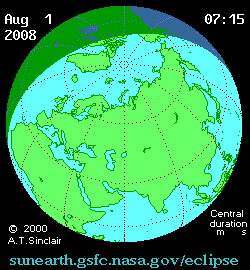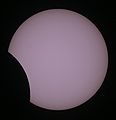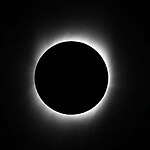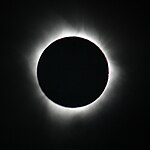Solar eclipse of August 1, 2008
| Solar eclipse of August 1, 2008 | |
|---|---|
 Totality showing corona from Kumul, Xinjiang | |
 Map | |
| Type of eclipse | |
| Nature | Total |
| Gamma | 0.8307 |
| Magnitude | 1.0394 |
| Maximum eclipse | |
| Duration | 147 sec (2 m 27 s) |
| Coordinates | 65°42′N 72°18′E / 65.7°N 72.3°E |
| Max. width of band | 237 km (147 mi) |
| Times (UTC) | |
| (P1) Partial begin | 04:06.8 |
| (U1) Total begin | 21:07.3 |
| Greatest eclipse | 10:22:12 |
| (U4) Total end | 21:28.3 |
| (P4) Partial end | 38:27.7 |
| References | |
| Saros | 126 (47 of 72) |
| Catalog # (SE5000) | 9526 |
A total solar eclipse occurred at the Moon's descending node of the orbit on August 1, 2008. A solar eclipse occurs when the Moon passes between Earth and the Sun, thereby totally or partly obscuring the image of the Sun for a viewer on Earth. A total solar eclipse occurs when the Moon's apparent diameter is larger than the Sun's, blocking all direct sunlight, turning day into darkness. Totality occurs in a narrow path across Earth's surface, with the partial solar eclipse visible over a surrounding region thousands of kilometres wide. It had a magnitude of 1.0394[1] that was visible from a narrow corridor through northern Canada (Nunavut), Greenland, central Russia, eastern Kazakhstan, western Mongolia and China.[2] Occurring north of the arctic circle, it belonged to the so-called midnight sun eclipses. The largest city in the path of the eclipse was Novosibirsk in Russia.[3]
The moon's apparent diameter was 1 arcminute, 17.8 arcseconds (77.8 arcseconds) larger than the February 7, 2008 annular solar eclipse.
This was the first eclipse this season, with the second being the 16 August 2008 partial lunar eclipse.
The total eclipse lasted for 2 minutes, and covered 0.4% of the Earth's surface in a 10,200 km long path. It was the 47th eclipse of the 126th Saros cycle, which began with a partial eclipse on March 10, 1179 and will conclude with a partial eclipse on May 3, 2459.[4]
A partial eclipse could be seen from the much broader path of the Moon's penumbra, including northeastern North America and most of Europe and Asia.[2]
It was described by observers as "special for its colours around the horizon. There were wonderful oranges and reds all around, the clouds lit up, some dark in silhouette, some golden, glowing yellowy-orange in the distance. You could see the shadow approaching against the clouds and then rushing away as it left."[5][citation needed]
The moon's apparent diameter was larger because the eclipse was occurring only 58 hours, 56 minutes after perigee.[citation needed]
Start of eclipse: Canada and Greenland[]

Animated path
The eclipse began in the far north of Canada in Nunavut at 09:21 UT, the zone of totality being 206 km wide, and lasting for 1 minute 30 seconds. The path of the eclipse then headed north-east, crossing over northern Greenland and reaching the northernmost latitude of 83° 47′ at 09:38 UT before dipping down into Russia.[4]
The path of totality touched the northeast corner of Kvitøya, an uninhabited Norwegian island in the Svalbard archipelago, at 09:47 UT.[citation needed]
Greatest eclipse: Russia[]
The eclipse reached the Russian mainland at 10:10 UT,[4] with a path 232 km wide and a duration of 2 minutes 26 seconds.[citation needed] The greatest eclipse occurred shortly after, at 10:21:07 UT at coordinates 65°39′N 72°18′E / 65.650°N 72.300°E (close to Nadym), when the path was 237 km wide, and the duration was 2 minutes 27 seconds. Cities in the path of the total eclipse included Megion, Nizhnevartovsk, Strezhevoy, Novosibirsk and Barnaul.[4] Around 10,000 tourists were present in Novosibirsk, the largest city to experience the eclipse.[3] For Gorno-Altaysk the eclipse was the second consecutive total solar eclipse after the March 2006 eclipse.[6]

Partial from Dmitrov

Magnitogorsk at maximum phrase
Partial from Moscow, Russia

Totality from Akademgorodok (Novosibirsk)
Diamond ring effect in Novosibirsk

Eclipse progression in Novosibirsk. All times UTC (local time UTC+7)

Partial from Pskov, Russia
Partial from Saratov, Russia

Partial from Yekaterinburg, Russia
Conclusion: Mongolia and China[]
The path of the eclipse then moved south-east, crossing into Mongolia and just clipping Kazakhstan at around 10:58 UT. The path here was 252 km wide, but the duration was decreased to 2 minutes 10 seconds. The path then ran down the China-Mongolia border, ending in China at 11:18 UT, with an eclipse lasting 1 minute 27 seconds at sunset.[citation needed] The total eclipse finished at 11:21 UT. The total eclipse passed over Altay City, Hami and Jiuquan.[4] Around 10,000 people were gathered to watch the eclipse in Hami.[3]

Totality in Altai City, Mongolia

Diamond ring effect in Kumul, Xinjiang

Totality in Jiuquan, China. Red prominences are visible on both sides of the sun
Totality in Jiuquan, China

Partial from Xi'an, China
Partial eclipse[]
A partial eclipse was seen from the much broader path of the Moon's penumbra, including the north east coast of North America and most of Europe and Asia.[2] In London, England, the partial eclipse began at 09:33 BST, with a maximum eclipse of 12% at 10:18 BST, before concluding at 11:05 BST. At Edinburgh the partial eclipse was 23.5% of the sun, whilst it was 36% in Lerwick in the Shetland Isles.[7]

The eclipse over Russia, Norway, and the Arctic Ocean as seen from NASA's Terra satellite.

Partial from Graz, Austria

Partial from Minsk, Belarus

Partial from Jodrell Bank Observatory, England

Partial from Huittinen, Finland

Partial from Bergen, Norway

Warsaw, Poland at maximum phrase

Partial from Kumla, Sweden

Partial from Makiivka, Ukraine

Partial from Chennai, India
LTU 1111[]
German charter airline LTU, now trading as Air Berlin, operated a special flight from Düsseldorf to the North Pole to observe the eclipse. Flight number LT 1111 spent over 11 hours in the air, returning to base at 6pm after flying a planeload of eclipse chasers, scientists, journalists and TV crews to watch the celestial event. The route also included a low-level sightseeing tour of Svalbard before the eclipse and the magnetic pole afterwards.
More details about the Total Solar Eclipse of 1 August 2008.[]
Eclipse Magnitude: 1.03942
Eclipse Obscuration: 1.08040
Gamma: 0.83070
Greatest Eclipse: 2008 August 01 at 10:22:12.3 TD (10:21:06.7 UTC)
Sun right ascension: 8.8
Sun declination: 17.9
Sun diameter (arcseconds): 1891.0
Moon right ascension: 8.82
Moon declination: 18.6
Moon diameter (arcseconds): 1948.2
Delta T: 1 minute, 5.7 seconds
Saros series: 126th (47 of 72)
Related eclipses[]
Eclipses of 2008[]
- An annular solar eclipse on February 7.
- A total lunar eclipse on February 21.
- A total solar eclipse on August 1.
- A partial lunar eclipse on August 16.
Tzolkinex[]
- Preceded: Solar eclipse of June 21, 2001
- Followed: Solar eclipse of September 13, 2015
Half-Saros[]
- Preceded: Lunar eclipse of July 28, 1999
- Followed: Lunar eclipse of August 7, 2017
Tritos[]
- Preceded: Solar eclipse of September 2, 1997
- Followed: Solar eclipse of July 2, 2019
Solar Saros 126[]
- Preceded: Solar eclipse of July 22, 1990
- Followed: Solar eclipse of August 12, 2026
Inex[]
- Preceded: Solar eclipse of August 22, 1979
- Followed: Solar eclipse of July 13, 2037
Solar eclipses 2008–2011[]
This eclipse is a member of a semester series. An eclipse in a semester series of solar eclipses repeats approximately every 177 days and 4 hours (a semester) at alternating nodes of the Moon's orbit.[8]
| showSolar eclipse series sets from 2008–2011 |
|---|
Saros 126[]
It is a part of Saros cycle 126, repeating every 18 years, 11 days, containing 72 events. The series started with partial solar eclipse on March 10, 1179. It contains annular eclipses from June 4, 1323 through April 4, 1810, hybrid eclipses from April 14, 1828 through May 6, 1864 and total eclipses from May 17, 1882 through August 23, 2044. The series ends at member 72 as a partial eclipse on May 3, 2459. The longest duration of central eclipse (annular or total) was 6 minutes, 30 seconds of annularity on June 26, 1359. The longest duration of totality was 2 minutes, 36 seconds on July 10, 1972. All eclipses in this series occurs at the Moon’s descending node.
| showSeries members 42–52 occur between 1901 and 2100 |
|---|
Metonic series[]
The metonic series repeats eclipses every 19 years (6939.69 days), lasting about 5 cycles. Eclipses occur in nearly the same calendar date. In addition, the octon subseries repeats 1/5 of that or every 3.8 years (1387.94 days). All eclipses in this table occur at the Moon's descending node.[9]
| showOcton series with 21 events between May 21, 1993 and August 2, 2065 |
|---|
Notes[]
- ^ Espenak, Fred; Jay Anderson (July 2004). "Total Solar Eclipse of 2008 August 01 - Parameters". NASA. Archived from the original on 2007-03-21. Retrieved 2008-08-01.
- ^ Jump up to: a b c "Total Solar Eclipse of 2008 August 01". NASA. August 1, 2008. Archived from the original on March 9, 2008. Retrieved 2008-08-01.
- ^ Jump up to: a b c "Total eclipse a dark show for thousands". Herald Sun. August 1, 2008. Retrieved 2008-08-01.
- ^ Jump up to: a b c d e Espenak, Fred; Jay Anderson (March 2007). Total Eclipse of 2008 August 01 - NASA Technical Bulletin 2007–214149. Retrieved 2008-08-01.
- ^ Dr John Mason describing the eclipse directly after observing it
- ^ Eclipses and Transits Visible in Gorno-Altaysk. timeanddate.com
- ^ Royal Astronomical Society (August 1, 2008). "Solar Eclipse On The Morning Of August 1st". ScienceDaily. Retrieved 2008-08-01.
- ^ van Gent, R.H. "Solar- and Lunar-Eclipse Predictions from Antiquity to the Present". A Catalogue of Eclipse Cycles. Utrecht University. Retrieved 6 October 2018.
- ^ Note S1: Eclipses & Predictions in Freeth, Tony (2014). "Eclipse Prediction on the Ancient Greek Astronomical Calculating Machine Known as the Antikythera Mechanism". PLOS ONE. 9 (7): e103275. Bibcode:2014PLoSO...9j3275F. doi:10.1371/journal.pone.0103275. PMC 4116162. PMID 25075747.
References[]
| Wikimedia Commons has media related to Solar eclipse of 2008 August 1. |
- Earth visibility chart and eclipse statistics Eclipse Predictions by Fred Espenak, NASA/GSFC
- Google Map
Photos:
- Russian solar eclipse
- Russian scientist observed eclipse
- Spaceweather.com solar eclipse gallery
- Total Solar Eclipse, August 1, 2008, from Russia by Jay Pasachoff
- Prof. Druckmüller's eclipse photography site. Mongolia
- Prof. Druckmüller's eclipse photography site. Russia
- The 2008 Eclipse in Russia
- Astronomy.com Eclipse trip images from Russia
- Memories, video and images of the eclipse by Crayford Manor House Astronomical Society
- The 2008 Eclipse in Russia
- [1] APOD 8/5/2008, A Total Solar Eclipse Over China, wide sky from near Barkol in Xinjiang, China
- [2] APOD 8/7/2008, At the Sun's Edge, Totality from Novosibirsk, Russia
- [3] APOD 8/8/2008, The Crown of the Sun, totality with corona from Kochenevo, Russia
- [4] APOD 9/20/2008,A Darkened Sky, totality with wide corona from Mongolia
- Webcast of the eclipse from northwest China
- University of North Dakota's Live Webcast from China
Video
- Total solar eclipses
- 2008 in science
- 21st-century solar eclipses
- Novaya Zemlya
- August 2008 events
- 2008 in Russia
- 2008 in Mongolia
- 2008 in China
- 2008 in Kazakhstan









































































